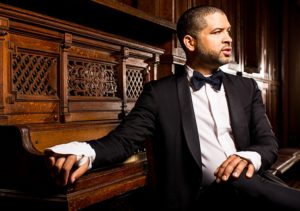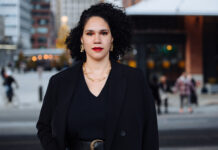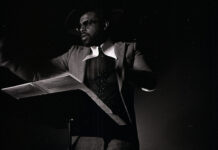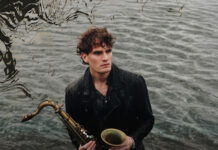In the Oscar-winning film La La Land, John Legend’s character says to Ryan Gosling’s Sebastian, “How you are you going to be a revolutionary if you’re such a traditionalist?” No one has ever asked pianist/composer Jason Moran that question and they are probably unlikely to.

Moran has proven himself to be one of the few artists who can bridge the past and the present together seamlessly. He was most recently seen in two different performances of his Fats Waller Dance Party. The first was at the Valley Performing Arts Center and the second was at Walt Disney Concert Hall. In each of these concerts he reimagined Fats Waller’s classic songs into something that he has described to “grab the audience’s attention as a call to share the vitality of music.”
In the process he creates something fresh and innovative. But he never ever loses a sense of respect for the innovators who came before.
One such innovator who influenced Moran is jazz legend Thelonious Monk. On Friday night Moran will be putting on his version of Monk’s legendary 1959 Town Hall Concert. This was the first time Monk was accompanied by an orchestra for performaces of his music.
The show, however, is not a strict note-for-note performance. Rather, the show is a multi-media presentation that fuses Moran’s interpretation of how the whole event happened. That’s why the show is called IN MY MIND: Monk at Town Hall. The CapUCLA performance takes place at the Theatre at the Ace Hotel.
Over the past few years I’ve had the chance to speak to Moran on and off the record several times. Here are some highlights from those conversations that I’ve never had a chance to publish before.
What impresses you most about Thelonious Monk?
I think of Monk and the way he played. It was so clean and so filled with the soil and the flower that came from the soil. He showed you it all. I’ve tried to continue that model.
What motivates you in putting together a show?
For me, the way I wrote and the way I have tried to figure out in the past four-to-five years is that context is everything. For me it’s really important to connect those histories because as we get further from Frank Sinatra, Miles Davis, John Coltrane, we can set them in the tombstone and leave them there. But I maintain the ideas we banter around so freely are those that these musicians set up for us a long time ago. Nothing is really new. It’s a different take that will hopefully stand the test of time.
What’s you’re relationship with Los Angeles artistically?

I wasn’t sure I understood LA until I got a bit older. It’s also a city where people like [jazz drummer] Billy Higgins had a major impact and artists like David Hammons really changed the dynamics of Afro-American relationship to progressive/conceptual art and how that culture fits into the conversation. A lot of my friends have been playing at the blue whale a lot. The younger generation of cats that I know, some great musicians, have left New York and have gone to LA. There’s a scene growing of people leaving NY and going to LA which is a good thing.
In 2011 you were at the top of the Downbeat Critics Poll. What pressure did that put on you?

That is no pressure. Pressure is playing in front of McCoy Tyner, Wayne Shorter, that’s pressure. What a magazine says is not pressure. Playing with [saxophonist] Charles Lloyd, it took a while to get accustomed to it. He’s been out there and he’s heard a lot of things. Sitting down at the piano and Herbie Hancock comes in to listen to a song. Can you convince him to listen to two songs? That’s pressure.
What is the future of jazz?
I think arts education is where it starts. We just need kids to be growing up still interested in what the arts are. Not simply as a field trip to see a symphony. It starts there. That students realize how much and how important culture is. The translates to the schools and the government. Especially for America which produces a wide variety of arts. It starts there.
If it starts there, where would you go next?
Then when we drill it down to jazz’s future, there’s a thing happening, time has moved with jazz. It is part of institutions like Harvard & Yale. So we start to see this thing that becomes part of curriculum at universities and emphasis is put on it as an older form of music but teaches a form of freedom. We have to break it down socially to what it mean when James Reese and the Harlem Hellfighters are playing the first big band music. What does he represent as an African American playing this music? And then people understand that this music offers us a plate or box to stand on to tell their story. This is powerful.
I often ask if people even know they are listening to jazz. Like if you are watching ice skating, if someone dances or skates to Miles Davis, do they know they are listening to jazz? Or Monk in the elevator? That waking up to how and what you are listening to is a very big part of determining our future
Photo Credit: Clay Patrick McBridge











